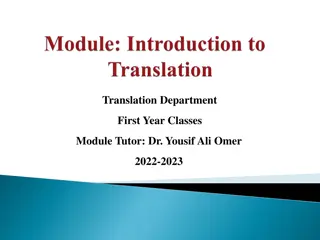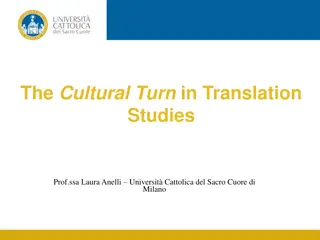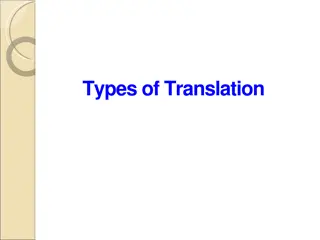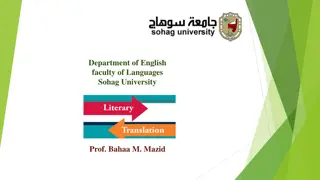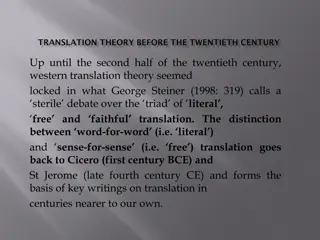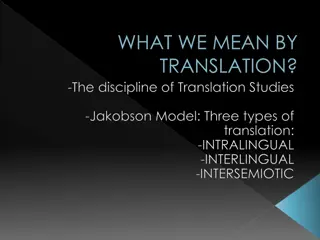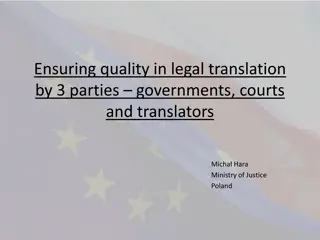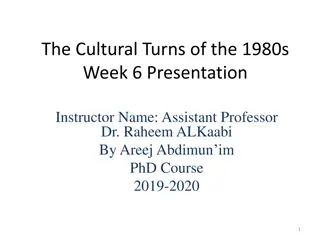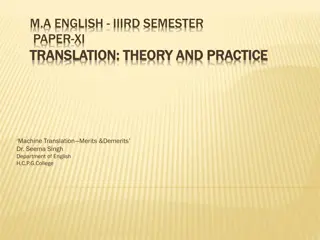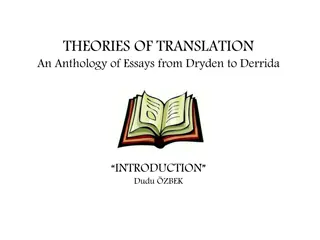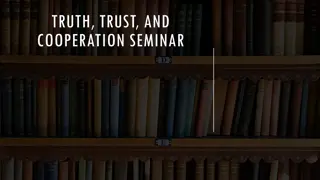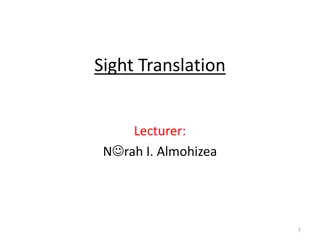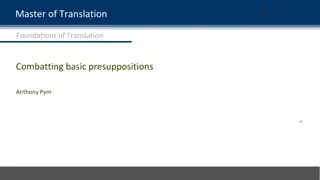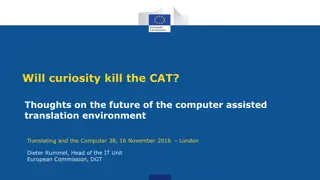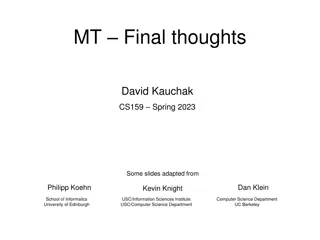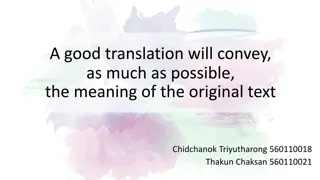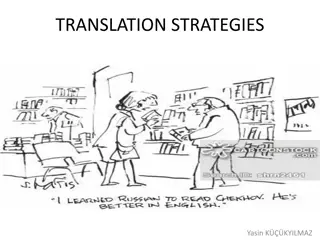Issues in AVT and Translation Studies Application
Shedding light on the inter-lingual transfer of verbal language through media multimodal translation in the field of Audiovisual Translation (AVT). Exploring Delabastita's model, film translation theories, and strategies for subtitling culture-bound issues in AVT.
Uploaded on Feb 27, 2025 | 0 Views
Download Presentation

Please find below an Image/Link to download the presentation.
The content on the website is provided AS IS for your information and personal use only. It may not be sold, licensed, or shared on other websites without obtaining consent from the author.If you encounter any issues during the download, it is possible that the publisher has removed the file from their server.
You are allowed to download the files provided on this website for personal or commercial use, subject to the condition that they are used lawfully. All files are the property of their respective owners.
The content on the website is provided AS IS for your information and personal use only. It may not be sold, licensed, or shared on other websites without obtaining consent from the author.
E N D
Presentation Transcript
In this presentation we will try to shed light on issues related to translation studies and how they can be applied in the field of AVT. As it is known, AVT is one of several overlapping umbrella terms that include media multimodal These different terms all set out to cover the inter- lingual transfer of verbal language when it is transmitted and accessed both visually and acoustically. This can create many issues on the transfer of linguistic factors from the SL to TL like the level of formality in which standard language and dialect can overlap. media translation multimodal translation translation , multimedia translation and screen multimedia translation screen translation translation , translation .
Delabastitas (1989) model is one of the earliest and most important in AVT that tried to frame film translation within translation theory. He claims that his model is an organized inventory of questions and hypotheses that should direct any future work (1989: 194) and that film establishes a multi-channel (acoustic and visual channels) and multi-code (the verbal, the literary and theatrical, the cinematic code, politeness codes, moral codes, and so forth) type of communication.
Any transfer of film signs from the source to the target set of codes needs to respect the material parameters within which any such translation process is necessarily accomplished. He then puts a scheme of potential translational relationships between a source film and a target film.
Diaz-Cintas and Remael (2007) talk about AVT with reference to subtitling. They do not adopt a specific model or theory of translation which might be applied to this kind of language transfer. They talk about the translation of marked speech such as dialect, the translation of culture-bound terms, songs, swearwords, and humour.
Some of the strategies that the authors recommend for subtitling culture-bound issues are loan, calque or literal translation, explicitation, substitution, transposition, lexical recreation, compensation, omission and addition. All these strategies are noticeably related to translation in general and not to AVT and cannot be said to constitute a model.
Karamitroglou (2000: 11) presents the following set of reasons to emphasize on the inclusion of AVT as a part of translation studies: a) Audiovisual translation has more in common with written translation than one might primarily assume (Whitman-Linsen, 1992:103). Most audiovisual translations at the present time are performed with a written form of the original source text in hand, sometimes even without any further access to the film product itself.
b) Typological studies in audiovisual translation have previously managed to present the various audiovisual language transfer methods within the general frame of translation studies and along with the other 'traditional' language transfer methods, in a coherent and scientific way, on the basis of the multiplicity of the semiotic channels involved and the relative time of presentation of the source and target products.
c) Audiovisual translation was born out of the same drive that conducted literary translation: the necessity to overcome the communication barriers imposed by linguistic fragmentation (Luyken et al., 1991:3).
d) Just as "it is the discovery of the hierarchy of factors (constraints, parameters) which operate in translation processes, procedures and products which constitutes a major task for translation theory" (Even-Zohar & Toury, 1981:ix), the discovery of a similar chain of the factors that function within audiovisual translation is also the task of audiovisual translation theory.
Written English is in many cases more formal than spoken English, and the same can be said about other languages including Arabic. So how is it possible to reflect less formal or informal English language in a formal Arabic style when film translation into Arabic? Before we answer this question, it is important to understand the mechanism of both dialects or language varieties of English and Arabic.
Dickins et al (2002: 165) argue that sociolect is defined in terms of sociological notions of class, and that sociolectal features can convey important speaker-related information. Consequently, if they are salient features of the ST, the translator cannot ignore them. On the other hand, the situations of Arabic is referred to as one of diglossia. Diglossia be defined as a situation language co speakers, functions. Dickins et al maintain, can where two varieties of a occur throughout a community of speakers, each having a distinct range of social functions. Diglossia, as , as Dickins et al maintain, can be defined as a situation where two varieties of a language co- -occur throughout a community of each having a distinct range of social
THANK YOU



